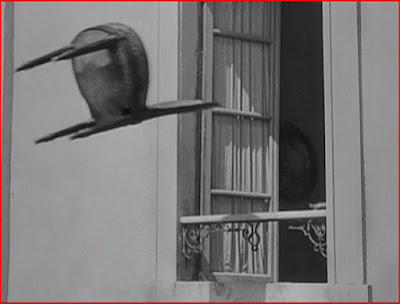 This is one of those "drop everything!" discoveries that the Albany Public Library frequently tempts me with: Rene Clair's 1927 adaptation of a classic 19th century farce in what Flicker Alley calls "the only fully complete edition...ever available to American viewers." I'm game for something like that, and the film lived up to expectations. It took a while, though. Clair is deliberate about establishing a large number of characters and their various quirks (tight shoes, deafness, cigarette habits) before ratcheting up the action. Once it gets going it has just the sort of pace that farce requires, the pace a failed farce like The Vampire Happening (see below) lacks completely. And once Clair establishes things, he gets more adventurous as a director.
This is one of those "drop everything!" discoveries that the Albany Public Library frequently tempts me with: Rene Clair's 1927 adaptation of a classic 19th century farce in what Flicker Alley calls "the only fully complete edition...ever available to American viewers." I'm game for something like that, and the film lived up to expectations. It took a while, though. Clair is deliberate about establishing a large number of characters and their various quirks (tight shoes, deafness, cigarette habits) before ratcheting up the action. Once it gets going it has just the sort of pace that farce requires, the pace a failed farce like The Vampire Happening (see below) lacks completely. And once Clair establishes things, he gets more adventurous as a director.The film updates the 1851 comedy by Labiche & Michel to 1895, but the basic situation could have worked in a silent comedy set in Clair's own time, except maybe for the horse. That animal belongs to Fadinard (Albert Prejean), who'll be our twit of a hero, and it starts the trouble by nibbling on the title chapaeu while Fadinard takes a break from riding to his wedding. The hat belongs to a woman on a tryst with an army officer who demands that Fadinard replace the ruined finery. Fadinard blows him off, but the officer and his girlfriend follow him home to press their complaint. The stakes are severe: the girl can't go home with a ruined hat because it would raise too many compromising questions about her activities that day. Her beau is a bit of a psycho as well as a nicotine fiend. He gives Fadinard an ultimatum. Regardless of his wedding plans, Ferdinand must deliver an exact copy of the I.S.H. to the couple, or the officer will literally destroy his home, one piece of furniture at a time.
Geymond Vital as the officer, in between fits of nicotine rage.
So Fadinard has to find excuses to leave his civil wedding ceremony to hunt down a duplicate I.S.H. at local millineries. It turns out to be a rare make, and the best he can do is learn the name of the last person to buy one. During his reception, he tracks down the home of the purchaser, only to learn that he's closed a circle of complications almost as tightly as a noose around his neck. Now he has to save his furniture, his newborn marriage, and the lives of his intruders, all without making an embarrassing scene for anyone, especially himself....
Clair's film has a slow start by the standards of American silent slapstick, but the story will not seem alien to American silent comedy fans. At times it may remind you of one of Hal Roach's better character-driven shorts, and the lead actor even looks and acts a little bit like Charley Chase. I could easily see Roach doing an Americanized version of the story (and for all I know, he did) with Chase as Fadinard and (for the sake of burlesque) someone like Jimmy Finlayson as the angry officer and imminent vandal.
As for adventurous direction, there's a startling bit around the midway point, during the reception, when Fadinard really starts worrying about what the officer will do to his house. To illustrate his hero's unsettling anxiety, Clair directs him going through the motions of the social dances in close-up with a handheld camera, and crosscuts these shots with Fadinard's imagination of the officer's reign of destruction. Chairs fly out windows, furniture surges out the door onto the street through stop-motion animation as scavengers swarm to take the items away, and finally the officer manages to blow up the entire building. In a later scene, as Fadinard tries to explain himself to a man who thinks he's being robbed, Clair goes retro, recreating the hat-eating scene and initial conflict between Fadinard and the officer in the most archaic, stagebound style, with his actors pantomiming in the most arm-sweeping fashion. These episodes are where Clair establishes his credentials as a versatile as well as an efficient comedy director.
Fadinard tries to keep up appearances at the reception, but he's got other things (like flying chairs) on his mind.
Flicker Alley says that the film was drastically edited for its initial English release in 1930 (it reached the U.S. a year later). I suppose I can understand why it was done, because American comedy fans would have demanded a faster pace. The first act in the restored version did seem slow to me, after all. But the more I see the better French comedies, the more I appreciate what I take to be their more atmospheric approach to establishing the all-important social setting for their stories. Little details are important in Clair's film, as he makes clear at the end by having some of the key props (shoes, gloves, ear trumpet, the I.S.H.) reappear as if for their final bows. They might not fully earn their encores if they aren't given time to establish themselves. We're definitely better off for history's sake to have the film in presumably complete form, and if that makes it seem slow for other viewers early on, take my word for it: it gets pretty funny later.




No comments:
Post a Comment